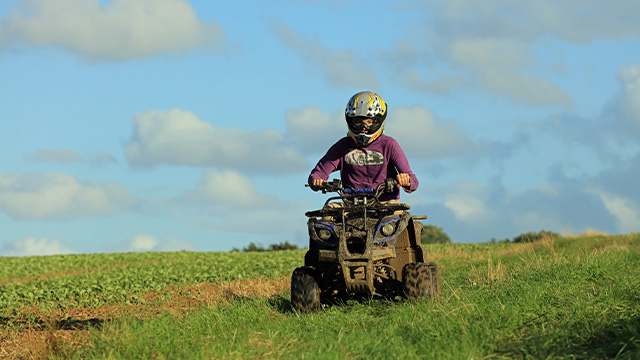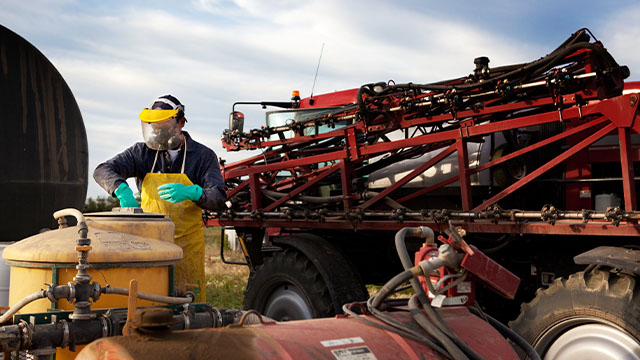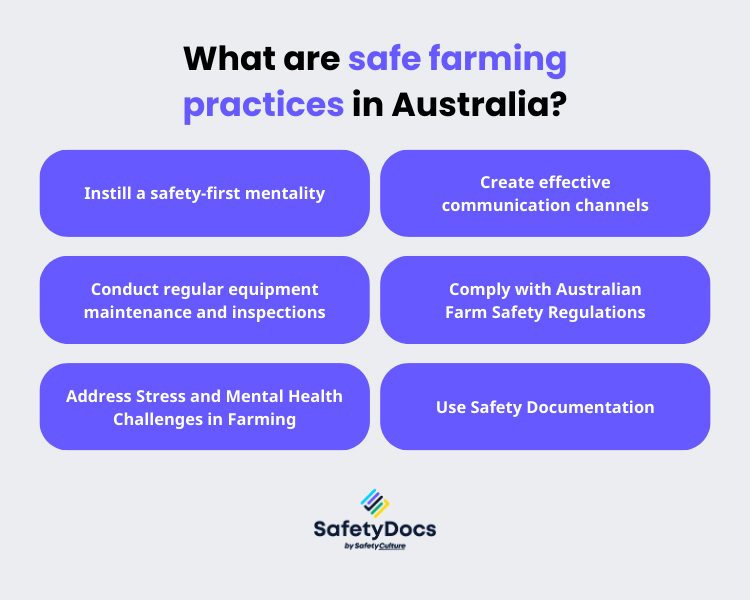Farming can be rewarding and challenging, but whether it's considered a safe job depends on various factors. Working on Farms involves heavy machinery, animals, and sometimes hazardous chemicals. This can pose a range of risks to farmer's health and safety. However, with proper training, equipment, and safety protocols in place, the risks of farm work can be minimised.
This comprehensive guide aims to assist and to educate the crucial aspects of farm safety, emphasising the significance of individual Standard Operating Procedures (SOPs) while promoting a culture of awareness and preparedness.

Farm Hazards
Since 2001, 1,705 individuals have tragically lost their lives in Australia, highlighting the significant risks associated with farming. The 2024 Safer Farms Agricultural Injury and Fatality Trends Report highlights that 32% of these tragic incidents result from accidents involving farm vehicles or mobile machinery on farms. 63% of those who lost their lives were over 45 years of age, with males accounting for 91% of the fatalities.
An ageing workforce, limited access to medical services, and the prevalence of independent workers compound these challenges. Understanding these hazards is the first step towards mitigating them effectively.
Common Hazards
- Machinery and Equipment Dangers: Working with heavy machinery such as tractors, quad bikes, and harvesters poses a significant risk of accidents, including rollovers, entanglements, and collisions. Additionally, equipment malfunction or improper use can lead to severe injuries or even death.
- Manual Task Injuries: Farm work involves a lot of manual labour, such as lifting heavy objects, repetitive motions, and prolonged standing or bending. These tasks can cause musculoskeletal disorders and strains if not performed correctly.
- Livestock Handling: Livestock such as cattle, horses, and pigs can be unpredictable and potentially dangerous when mishandled. They may kick, charge, or trample workers if provoked or frightened.
- Chemical Exposure: Farmers often work with pesticides, herbicides, and fertilisers. Exposure to these substances can lead to respiratory problems, skin irritation, and other health issues if you don't take the necessary precautions.
- Slips, Trips, and Falls: The uneven terrain of a farm, combined with cluttered work areas, can increase the likelihood of slips, trips, and falls. These accidents can result in broken bones or head injuries.
- Working Alone: Many farmers work alone for long periods. In an emergency, it is essential to have a communication plan to contact someone for help.
- Mental Health: Farming can be a physically and mentally demanding job. Farmers often face high levels of stress, isolation, and financial pressure. Farmers need to prioritise their mental health and seek support when needed.
- Weather Conditions: Extreme weather events, such as storms, floods, or heatwaves, can threaten farmers and their crops. Exposure to extreme temperatures or severe weather conditions can lead to heatstroke, dehydration, or frostbite.
Seasonal Hazards
- Summer: During the summer months, farmers may face risks associated with high temperatures, dehydration, and heat-related illnesses. Additionally, the risk of bushfires increases in dry conditions, threatening property and personal safety.
- Winter: In winter, farmers must contend with cold temperatures, icy conditions, and reduced daylight hours. Slippery surfaces increase the risk of slips, trips, and falls. At the same time, exposure to cold weather can lead to hypothermia and frostbite.
- Spring: Spring brings hazards, including heavy rainfall, flooding, and rapidly changing weather patterns. Farmers may need to deal with waterlogged fields, making machinery operations more challenging and increasing the risk of accidents.
- Autumn: Farmers face hazards such as decreased visibility due to fog or low light conditions during autumn. Falling leaves and debris can pose risks, particularly when operating machinery or working near trees.

Safe Farming Practices in Australia
Instil a safety-first mentality
A safety mindset is crucial for farming operations. This means being vigilant, aware of potential hazards, and taking proactive measures to prevent accidents. A safety culture in any industry starts from the top, so farm owners and managers must lead by example. This can include conducting regular safety toolbox talks with workers, providing thorough training on safe farming practices, and consistently reinforcing the importance of following safety protocols.
Create effective communication channels
Workers should feel comfortable reporting potential hazards or unsafe situations, employers and managers should listen to their concerns and take appropriate action. This could include having an emergency contact list readily available, implementing a messaging system, or using radios or walkie-talkies.
Conduct regular equipment maintenance and inspections
Regular maintenance schedules and thorough equipment inspections prevent malfunctions and breakdowns. Equipment like machinery or vehicles should be regularly checked and repaired if necessary. This ensures workers' safety and increases equipment's longevity and efficiency.
Implement safety training programs
Safety training programs for farmers include teaching them about properly handling hazardous chemicals, using protective equipment, and emergency response procedures.
Personal Protective Equipment (PPE)
Proper utilisation of PPE, such as helmets, gloves, and goggles, can significantly reduce the risk of injuries. Ensuring access to appropriate PPE and enforcing its usage is imperative for safeguarding workers.
Handling hazardous chemicals
Farmers should be trained on how to handle and store hazardous chemicals safely. This includes understanding the risks, proper storage techniques, and emergency response procedures in case of spills or accidents.
Emergency response procedures
In addition to handling hazardous chemicals, farmers should also receive training on emergency response skills and procedures. This can include knowing how to properly use fire extinguishers, first aid techniques, and emergency evacuation protocols.
Comply with Australian Farm Safety Regulations
Agriculture is one of the most dangerous industries because of its combination of hazards. Most high-risk activities require specialised safety measures to prevent accidents and injuries. Farmers must comply with safety laws to ensure a safe working environment.
Model WHS Regulations
The person conducting a business or undertaking (PCBU) in agriculture must still followWork Health and Safety (WHS) Regulations. These regulations provide a consistent framework for workplace health and safety laws. It ensures that all workers are entitled to the same level of protection regardless of which state or territory they work in.
Under these regulations, farmers are legally obligated to identify hazards on their farms and implement control measures to eliminate or reduce risks as much as reasonably practicable.
Emergency Preparedness
Farmers must prepare and maintain an emergency plan for the workplace to guide workers and visitors on what to do in an emergency. Make the plan easily accessible, regularly reviewed, and updated.
ISO Compliance
The agriculture industry can benefit from ISO certification, primarily through standards such as ISO 14001. This standard emphasises environmental management to foster sustainable farming practices and mitigate environmental impacts.
Address Stress and Mental Health Challenges in Farming
Farm workers are often remote and isolated, working long hours in physically demanding and mentally taxing conditions. This can increase stress and mental health challenges for farmers and their employees. As an employer, it is essential to recognise these potential issues and take proactive steps to address them. Offer access to mental health resources, advocate for work-life balance, and introduce stress management strategies for farm operations.
Use Safety Documentation
Documents such as safety manuals, hazard assessments, and Standard Operating Procedures (SOPs) are invaluable tools for ensuring safety on the farm. Here's why:
- Clarity and Consistency: Safety documentation provides clear guidelines and procedures, reducing the risk of misunderstandings and helping maintain consistent safety practices throughout the operation.
- Preparedness: These documents prepare workers to handle potential hazards and emergencies confidently, ultimately minimising risks and incidents.
- Accessibility and Review: Keeping safety documents readily accessible empowers workers with the knowledge they need. Regular reviews and updates maintain their relevance and ensure the farm's safety program stays up-to-date with best practices and regulations.
Standard Operating Procedures (SOPs): Your Farm's Blueprint for Safety and Efficiency
Standard Operating Procedures (SOPs) are detailed instructions that guide workers on how to perform tasks safely and effectively. Think of them as your farm operations manual! They're not just crucial for farming; SOPs benefit any workplace. Here's why they matter:
- Minimise Risk: SOPs help prevent accidents and injuries by outlining the safest methods for every task.
- Promote Consistency: Everyone does things the same way, the right way. This ensures quality and reduces errors.
- Boost Accountability: Everyone knows their responsibilities, which promotes a strong safety culture.
Essential SOPs for Australian Farms (available from SafetyDocs):
- Quad bikes: Navigate the risks of quad bike use with clear guidelines for safe operation, training, and maintenance. It also includes an Employee Training and Induction Register.
- Farm Machinery: Minimise tractor-related incidents with step-by-step procedures for safe operation.
- Bore and Windmill Maintenance: Ensure safe practices when working with bores and windmills – covering preparation, electrical hazards, and potential animal encounters.
Agricultural Management Systems: The Backbone of Successful Farming
Think of management systems as the framework that keeps your farm running smoothly. They organise your daily operations, optimise how you do things, and pave the way for greater efficiency. Here's why they matter:
- Structure and Clarity: Management systems bring order to the everyday. They set clear expectations, streamline tasks, and help your entire team work in sync.
- Best Practices Built-in: Why reinvent the wheel? Management systems incorporate established standards (like AS/NZS ISO 45001:2018, ISO 14001:2016, and ISO 9001:2016) to elevate your farm's safety, environmental efforts, and overall excellence.
- Boosting the Bottom Line: Management systems aren't just about compliance – they're about results! They help you optimise resources, minimise waste, and ultimately increase your farm's productivity.
Key Management Systems to Consider:
- Integrated Management Systems: An all-in-one system that combines safety, environmental impact, and quality management. It's a smart foundation for farms of all sizes.
- Environmental Management System: Put sustainability front and centre. This system helps you minimise your farm's environmental footprint and adopt earth-conscious practices.
Incorporating these management systems into daily operations can significantly improve the efficiency and effectiveness of a farm. Farmers can better manage their resources, minimise waste, and increase productivity by having clear guidelines and processes.

SafetyDocs for All Your Farm Safety Needs
To improve your farm's safety and environmental practices, consider utilising SafetyDoc by SafetyCulture. We are Australia's most trusted safety document provider. With customisable templates for various farming activities, such as the Agricultural SOP Pack and Integrated Industry Suite, SafetyDocs can help streamline your safety procedures and ensure compliance with regulations.
Furthermore, we also have the following templates specifically designed for farm operations:
- Agricultural HSEQ Management System for New Zealand
- Remote-Isolated Work Safe Work Method Statement
- Emergency Response Plan
With SafetyDocs, your safety protocols are well-documented and easily accessible. Equip your team with the knowledge they need to stay safe while working on the farm. Protect your workers, your farm, and yourself by using SafetyDocs as your go-to safety document provider.
Our team of experts is dedicated to providing accurate and informative content. Craig Cruickshank, our senior HSEQ advisor at SafetyDocs by SafetyCulture has reviewed this blog post to ensure the highest level of quality.
Learn more about Craig's work on LinkedIn for more industry insights.
Available for instant download and supplied in fully editable MS Word format for use in your business.
Please note that the above information is provided as a comment only and should not be relied on as professional, legal or financial advice.
Share This Article
